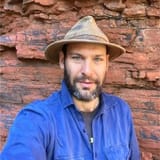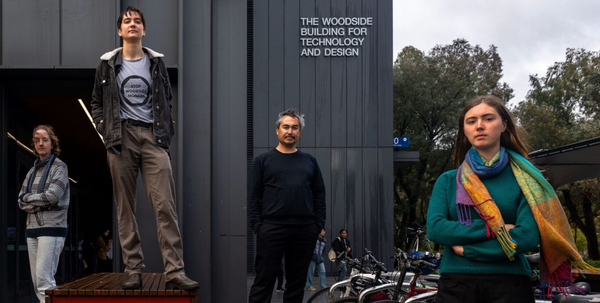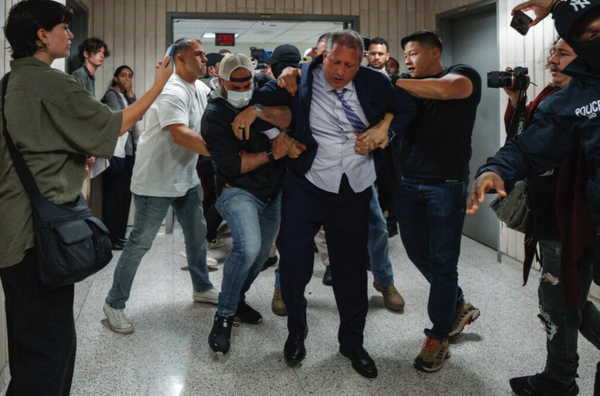Inside UNESCO
Reflections from Paris on World Heritage for Murujuga
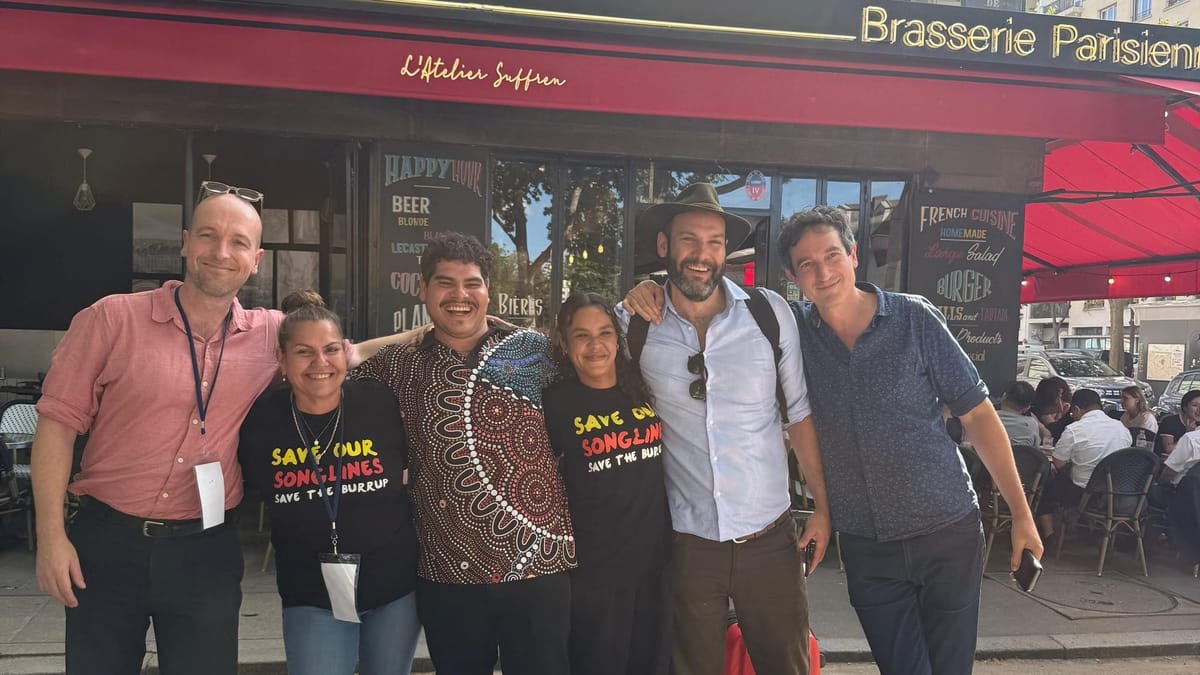
Earlier this month I had a front row seat as Murujuga traditional custodians took the fight to protect their Country to the UNESCO World Heritage Committee in Paris. While Save our Songlines had attended a special meeting of the UN Human Rights convention in Geneva and I had experience at UN climate conferences, none of us had been to a UNESCO meeting before. We were unsure what Save our Songlines could achieve by attending the UNESCO meeting in Paris where the Murujuga World Heritage nomination would be considered, but we all felt compelled to be there, and I’m glad we made the effort.
Save our Songlines founder Raelene Cooper and her family had a gruelling schedule that saw them travel from their home in the Pilbara to Paris via New South Wales for campaign commitments on either side of the UNESCO trip. By coincidence, I would already be in Europe on the only overseas trip I have ever taken purely for leisure (until the call-up came in for Paris). At least I would find it easier to justify the carbon emissions.
Despite our apprehensions, we felt it was critical that we take the opportunity to share the truth about what was going on at Murujuga on a global stage. And we felt we had a duty to counter the increasingly emboldened narrative coming from Woodside and the Albanese Government that ongoing oil and gas development (including the 50-year North West Shelf extension) could coexist with the incredible Murujuga heritage values.
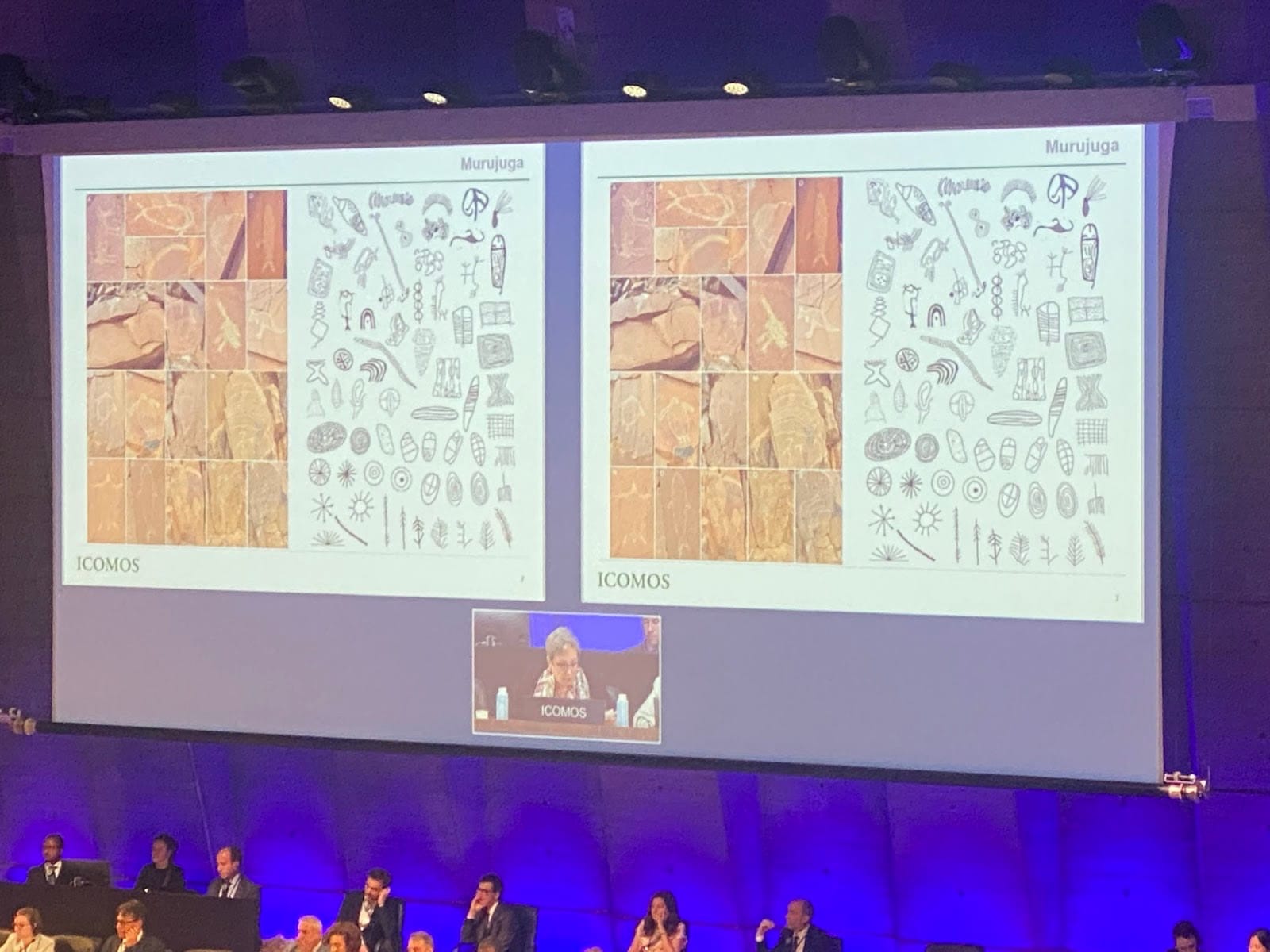
Independent expert advisory body ICOMOS had previously provided a report to UNESCO that informed its draft decision, made public in late May. That report acknowledged the ‘Outstanding Universal Values’ (OUV’s in UNESCO speak) of Murujuga in several categories - more than worthy of inscribing the site on the world heritage list.
That was to be expected - nobody could deny the outstanding values. But to our surprise, after years of stonewalling from the WA government, ICOMOS had taken the industrial threats seriously. The report warned of ongoing damage to the heritage values unless major improvements were made, and singled out the North West Shelf Extension as a major concern due the effects of its pollution on the rock art.
It was a breakthrough that the world’s most experienced expert body on heritage had acknowledged this, providing weight and credibility to arguments that had been ignored for so long in the gas-addicted petro-state we call home.
But ICOMOS did not stop there - they had gone further, making important management recommendations including a moratorium on further industrial development, a total removal of acid gas emissions, and the development of a decommissioning and rehabilitation plan for industry on Murujuga. The draft UNESCO decision called for the listing to be deferred (or referred back to the Australian Government) to allow time for these policies to be put in place.
Just days after receiving this report, Environment Minister Murray Watt would make a move almost as astonishing as it was cynical. Without even visiting Murujuga, the Minister announced a Proposed Decision to approve the North West Shelf Extension. This would enable the largest source of industrial pollution on Murujuga to continue operations till 2070, flying directly in the face of the ICOMOS recommendations.
Under pressure over the approval, Watt needed to show that his decision would not wreck the heritage nomination. He needed to fulfill his reputation as a fixer. The stakes were high and the Minister was making a big gamble, but there were a couple of major factors on the Minister’s side.
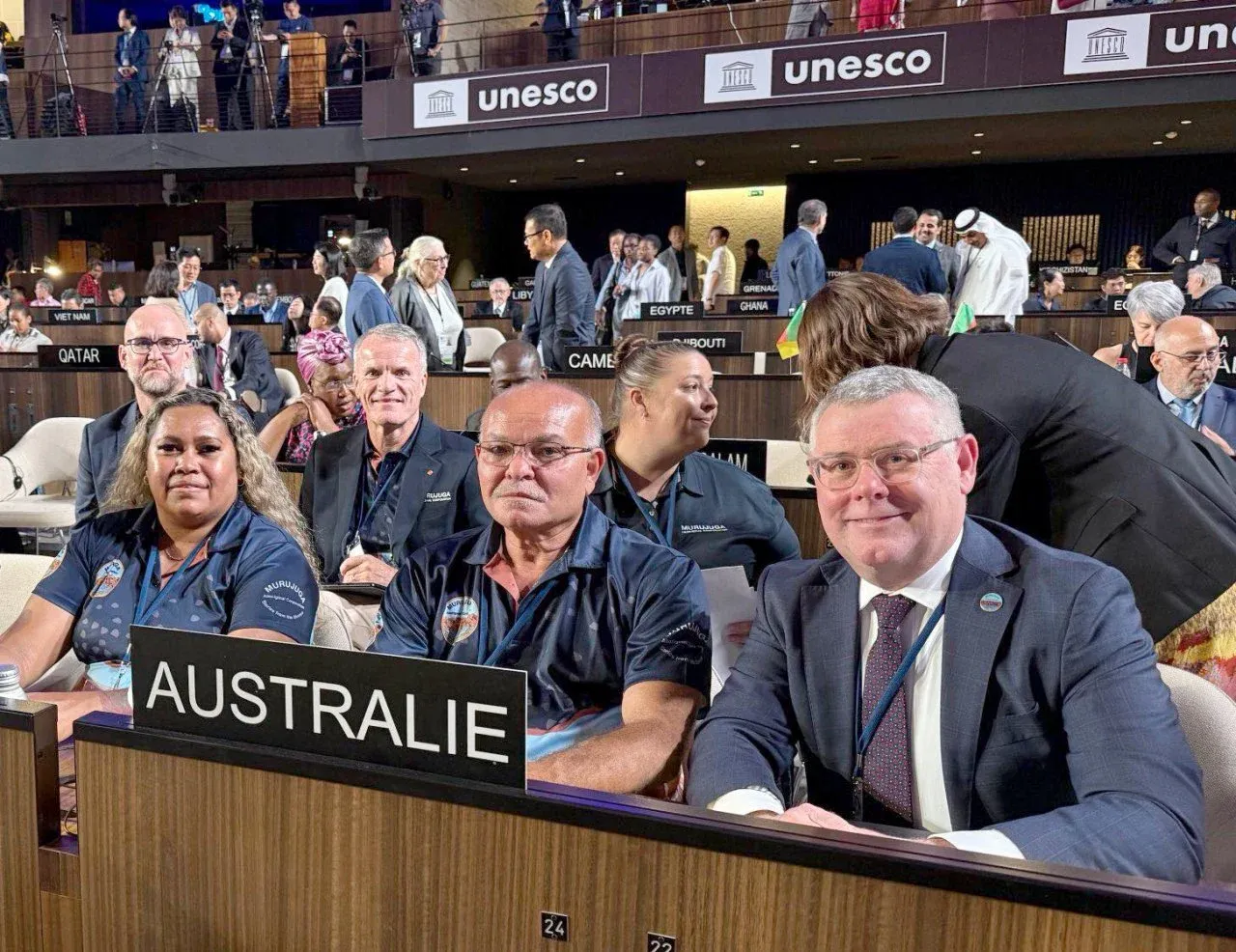
The first is that the Murujuga Aboriginal Corporation had been pushing for the heritage inscription for years, and the organisation had put a huge amount of effort into developing the nomination documents. Over this period, a view had come to prevail within MAC - strongly encouraged by the state and federal government - that a successful listing would require UNESCO to be convinced that Woodside’s gas facilities and other industry on Murujuga were not putting the heritage values at risk.
This belief, combined with other factors, had set the scene for MAC’s official position to become far more amenable to industrial development. MAC’s original posture, guided by the Circle of Elders and enshrined in the Murujuga Cultural Management Plan over a decade ago, called for industry to eventually be removed from Murujuga. By now, the group had pivoted to provide full-throated promotion of co-existence with industrial development in the name of securing the World Heritage listing.
The second major thing that the Minister had in his favour was that after months of refusing to release the much-anticipated MRAMP rock art monitoring report, the WA Government had finally found a way to explain away the measured damage to the petroglyphs without putting Woodside in the firing line. Even though the arguments were implausible in multiple ways, and immediately refuted by independent experts, the WA Government’s bold assertions that the damage had been caused by historical acidic emissions and current Woodside emissions were benign would give Watt exactly what he needed. Armed with this new ‘evidence’, Minister Watt now had the confidence to directly challenge expert body ICOMOS on their findings, and to argue that current and even expanded industry was not in fact threatening the heritage values as they claimed.
Australia is not currently a voting member of UNESCO, so Watt would have to rely on other countries on the Committee. By the time we arrived in Paris at the tail end of a blistering heat wave in the French capital, it was clear that a massive diplomatic effort had already been mobilised by the Australian Government to bring UNESCO members around to the Woodside / Watt view of the world.
We arrived at the conference on Monday and the Murujuga item was scheduled for discussion on Friday afternoon. That gave us less than a week to influence the outcome. Raelene’s objective going into the conference, discussed over the previous weeks, was to support the listing or inscription of Murujuga on the World Heritage List, while at the same time retaining as much as possible of the ICOMOS recommendations for protection.
As soon as the conference was underway, media reports started to come through confirming that Watt had already convened a large meeting of member country’s ambassadors. His aim was to convince UNESCO to inscribe Murujuga on the heritage list, but to remove or render meaningless all of the key management recommendations that had been suggested by the expert body. That way, the Minister could return to Australia with an international endorsement, not only for the existing management of industry on Murujuga, but of his decision to approve the North West Shelf extension.
We knew it would be an uphill battle, but we were determined to put up some resistance, and maybe even hold some ground on the ICOMOS recommendations.
It was no surprise that the most sympathetic early adopters of Australia’s position were countries where Woodside and its joint venture partners have interests, or receive the gas produced at Murujuga. From that starting point the diplomatic effort quickly gathered momentum so that by the time the item was debated by the UNESCO Committee, Australia already had almost half of the 20 UNESCO members signed up and buckled in for the ride.
Despite repeated requests, only a few sympathetic countries granted us formal meetings. In one of our first encounters, we were advised that the Kenyan delegation was already circulating a draft motion on behalf of Australia to amend the ICOMOS recommendations. Later, in a side room away from the main conference chamber, I happened to take a seat across from Rae and the others at a small table, directly beside the delegates we were meeting. They briefly turned their laptop towards me so I could see the words as they scrolled through the draft motion. The red strike-through text jumped off the screen and our worst fears were quickly confirmed. Every one of the expert recommendations that would protect the heritage values had been struck out in red track-changes, replaced with vague language that would allow ongoing industrial development and ongoing acidic emissions. We were informed that Kenya was gathering co-authors for the motion, but at that stage it was not known if any other countries had signed up.
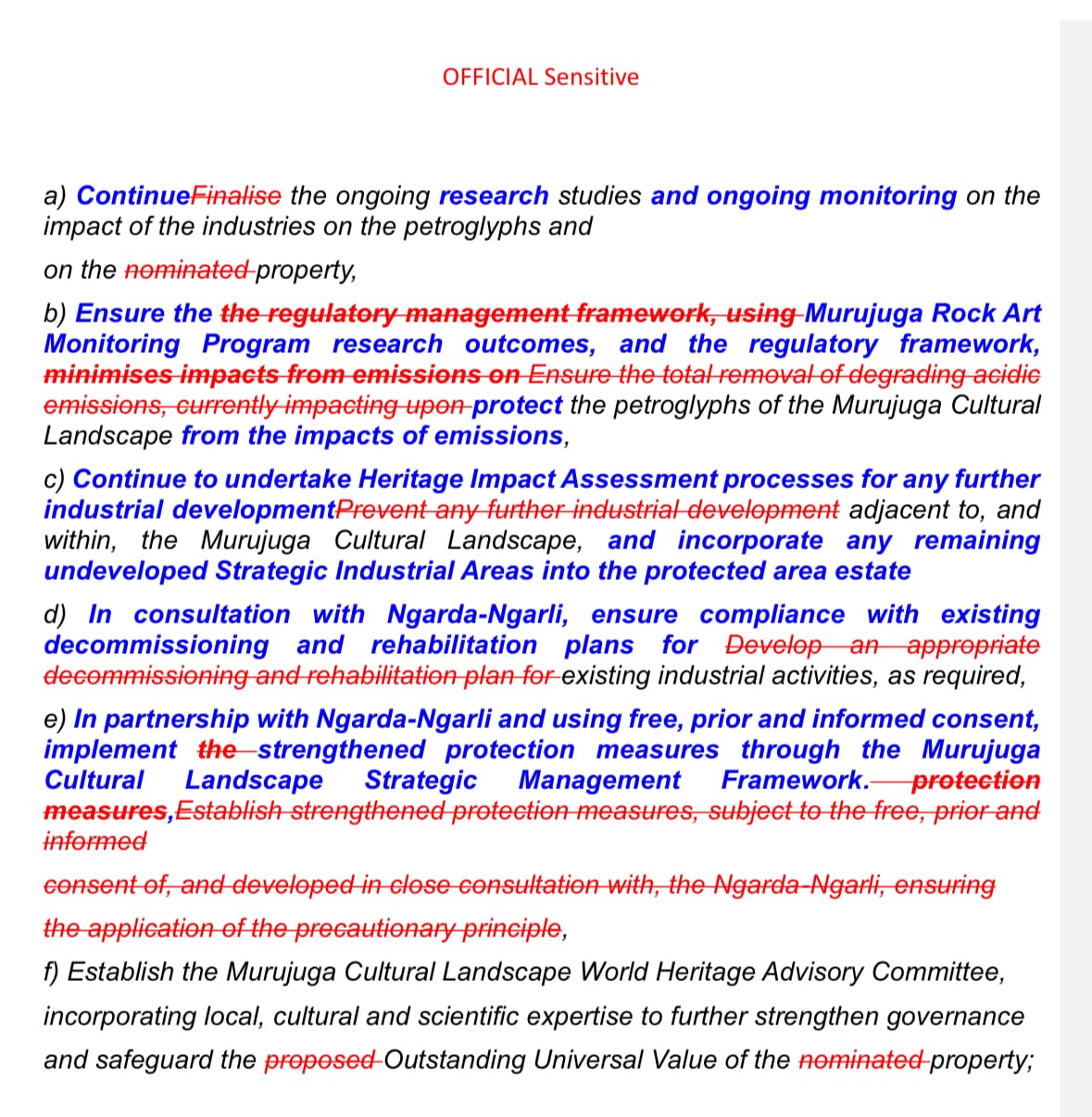
On the advice of experienced NGOs we met in the corridors, we quickly realised we would have to resort to approaching countries directly at their desks in the main plenary chamber in the breaks between sessions. Rae was a natural at this, approaching ambassadors and their staff with a disarming smile, then delivering her own heartfelt and often emotional account of the damage being done by Woodside and other industry to her beloved Ngurra back home at Murujuga. I mostly sat quietly in tow until it came time to answer questions, provide information, show pictures, or make a specific request for assistance.
During these meetings, it became very clear that none of the information that had been provided to UNESCO members had given them an accurate impression of the scale of industry, or the proximity to the rock art on Murujuga. The landscape pictures that were included in the nomination documents were carefully framed to avoid the gas flares, flattened areas or industrial scars on the landscape. And even though the ICOMOS report contained strong warnings about acid gas emissions and other industry impacts, it was in dry technical language with no pictures to convey the almost unbelievable reality of what is occurring at Murujuga.
Many countries listened politely and even appeared to express genuine sympathy for our position, but by the end of day two we were already picking up a strong feeling of inevitability around the Australian government position. We were making a particular effort to meet with Kenya, and Rae had approached their desk several times to ask for meetings about the motion they were sponsoring on behalf of Australia. These approaches were met with degrees of hostility that became less and less diplomatic with each approach. It was clear the Kenyans did not want to talk with us, and had no intention to reconsider what they were doing.
Several months prior, MAC had engaged one of Australia’s leading PR firm, whose senior partner previously lobbied for the Mineral Council of Australia for many years. MAC’s current chair Peter Hicks had sharpened his public criticism of NGOs, alleging they were ‘politicising the process’ on the heritage listing and undermining the nomination. Every single media statement, every briefing note, and every social media post had been very clear that Save our Songlines supports the heritage listing but it must include protections from damaging industry. We were winning the media back home, with prominent stories framed in our favor in most of the major outlets every day. When the much-anticipated German rock art PHD was finally published at the start of the week, this provided fodder for a fresh round of coverage.
With the snub from the Kenyan delegation, we decided to brief media on the Kenyan amendment. This enabled us to frame it clearly as an effort to strip away and water down the protections recommended by expert body ICOMOS, even though Minister Watt was positioning it as a major win for heritage listing. Our messaging dominated the headlines back home on the day before the decision.
Back in the tiny Paris hotel where I was staying, I had set up a makeshift office in the breakfast room downstairs and I had been working overnight to update our briefing materials and sharpen our request to member countries in response to developments. Martin, the French-speaking interpreter we invited along enthusiastically took to printing these out each morning, accompanied by a growing dossier of evidence and media clips. While curious French journalists watched on, we took over the media space at the conference centre to compile the packages for delivery to the desks of the member delegations in the main conference chamber.
All of this, and our visible lobbying presence was clearly beginning to annoy the Australians. The Aussie diplomats could be seen in huddles watching us from the conference floor or the viewing galley above, checking who we were meeting with so they could follow up with them afterwards. This put a noticeable dampening effect on our interactions as the other countries became increasingly uncomfortable meeting with us. As the conference progressed, we became aware the Australians were heavily briefing other delegations against us and recommending not to engage with us at all.
On the day of the decision when Minister Watt arrived, security at the conference center ramped up massively. That morning, we were denied access to the main chamber, but it seemed other observers were not being barred in quite the same way. Minister Watt was clearly going to some lengths to avoid a public confrontation at the conference. With Rae’s case against the Minister before the court, she knew better anyhow. But the security presence made it feel like intimidation was an intended outcome rather than a side effect of managing the optics. By mid-morning on the final day, our whole team could feel a heavy oppressive feeling in the centre, and the exposed concrete mid-century modernism of the UNESCO building started to take on much more brutalist overtones.
At times shaking and sweating with anger, Rae, Mark, Skyler and Glenn found the strength to stay and listen to the Kenya amendment in the observers gallery with the rest of our small team - all the while being filmed by Quentin and Kelly, the documentary crew who had been covering our UNESCO mission. The first statement from a member country, Mexico, stressed the need to maintain the protections and we briefly started to lift our hopes. But what followed was country after country reading prepared statements congratulating Australia and confirming they would support the motion.
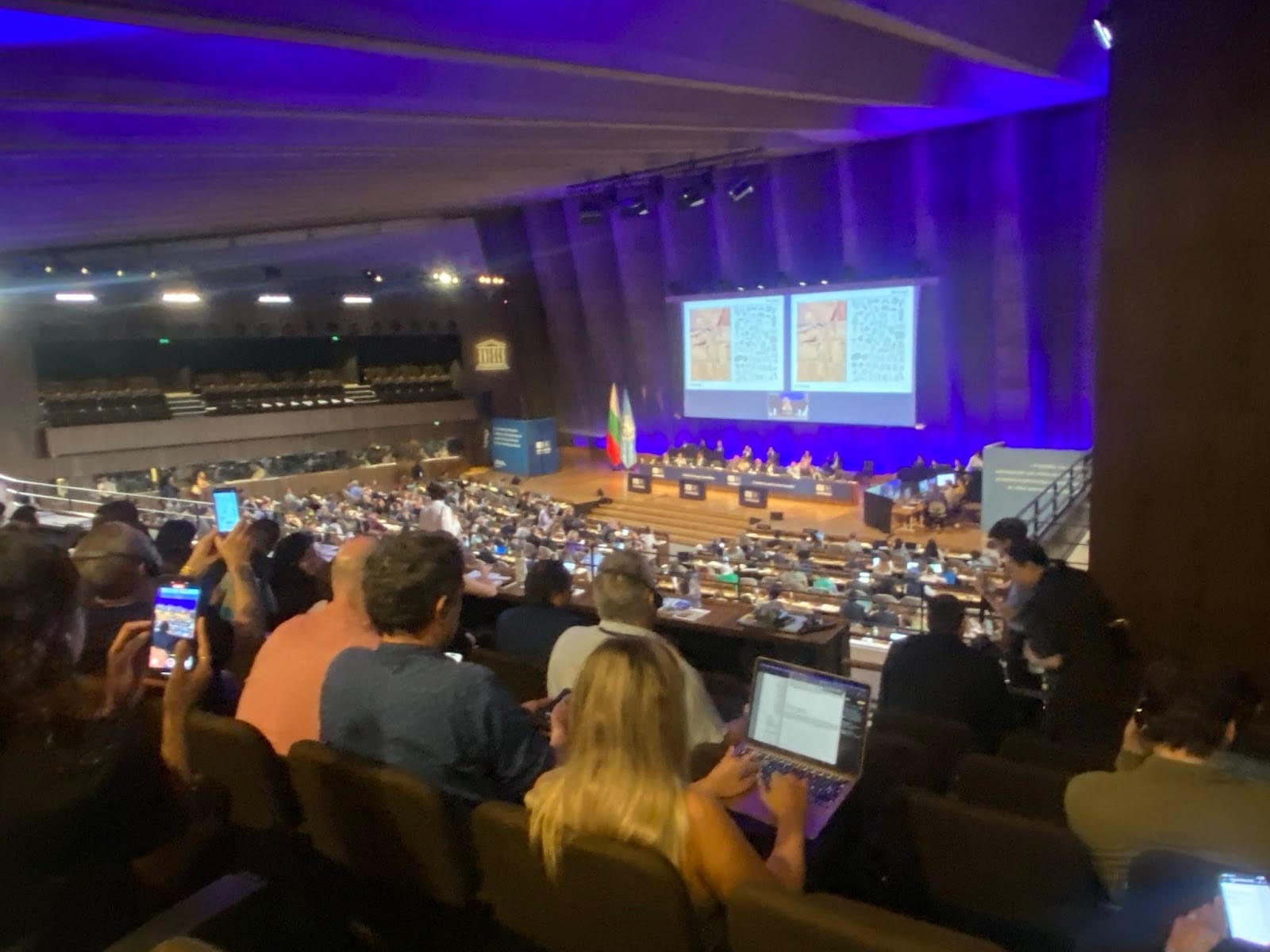
Sitting at the Australian delegation desk with MAC members, Minister Watt looked particularly pleased when the red strike-through text came up on the screen, confirmation that the inconvenient and embarrassing ICOMOS recommendations to improve protection and management would be consigned to the dustbin. In what seemed like pre-prepared ‘Dorothy Dixers’ several of the UNESCO members invited Australia’s response to questions about the monitoring report and management arrangements. This gave the Minister an opportunity to speak and his responses were perhaps the most breathtaking part of the whole exercise.
Just days after being reported back home agreeing that Australia’s environment laws are badly broken, the Minister claimed before UNESCO that the same laws were providing strong protection for Murujuga. Such contradictions are standard fare in politics, but it was the Minister’s claims around the rock art science that was even more blatant and disturbing.
I’m pretty cynical when it comes to government ignoring science but I have never before seen such a deliberate and blatant misrepresentation of scientific evidence as by the Australian government on this issue. The conclusions being claimed about the rock art damage and the acid deposition are not only inconsistent with the governments own published data, but are based on completely implausible propositions that have clearly been fabricated to provide cover for Woodside and its continued LNG operations. This effort is not just a case of an elected government ignoring science (that happens every day on climate change) but it goes further to willfully misrepresenting and fabricating scientific evidence to justify a position that is fundamentally detrimental to some of the World’s most significant and valuable heritage.
The expert body ICOMOS was clearly unconvinced, and stood by its report and recommendations. However Australia was able to ride right-shod over this, having convinced several countries to include Australia’s misleading talking points on the rock art monitoring in their speeches to the Committee. For me, and no doubt others who have been following this issue, this facade totally undermines any faith in international institutions like UNESCO, or in the basic idea of science-based decision making. If UNESCO member countries are knowingly or otherwise willing to let this happen, it fundamentally undermines the entire basis of the institution and everything it stands for.
At the end of the day, there is still something worth celebrating about the outcome and that is what we focussed on after the decision. Despite what occurred, the inscription of Murujuga on the World Heritage list is a massive achievement for those who worked towards it, and will help bring international attention to what is happening on the Burrup.
We were proud that we had done our best at a difficult job of speaking truth to power. We were glad that we had brought the truth of Murujuga to the UNESCO members, and perhaps laid the foundations for greater accountability in the future. And we were confident that if we had not done what we did, then nobody else would have. For my part I’m proud to stand with an incredibly strong and brave woman and family who are fighting for their Ngurra. Whatever the outcome, I’m proud that we did the right thing by Murujuga.

